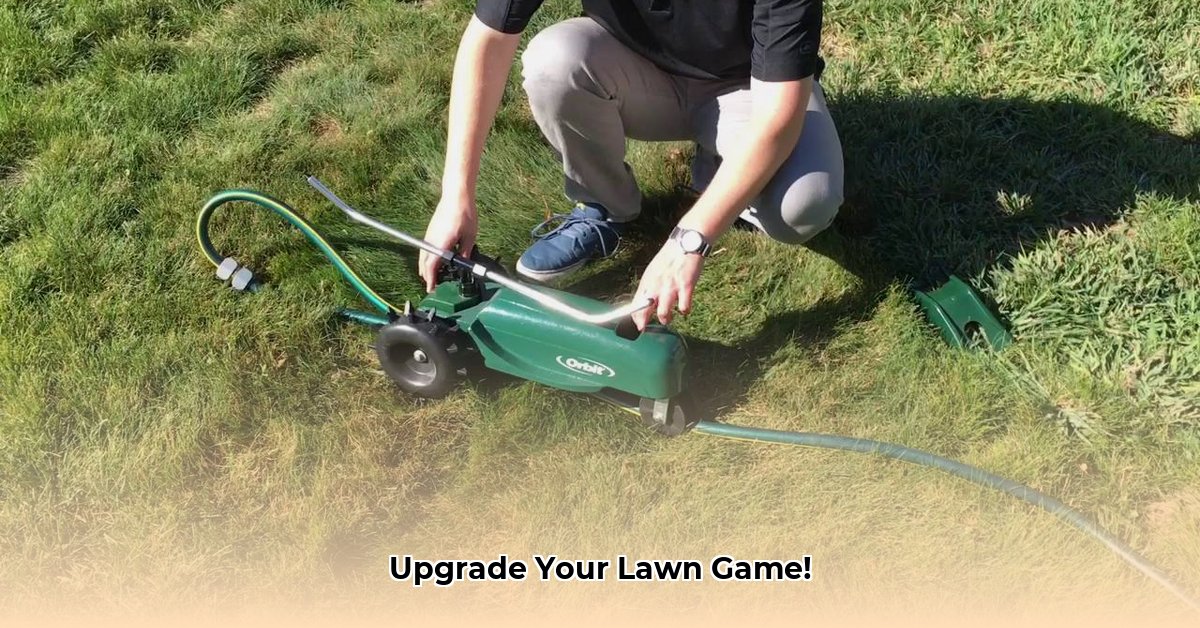
Choosing the right lawn water tractor (traveling sprinkler system) can significantly improve irrigation efficiency and save you time and resources. This comprehensive guide helps you navigate the options, understand key features, and select the perfect model for your needs, whether you're a homeowner or a large-scale agricultural operator. For more information on powerful ride-on options, check out this helpful resource.
Understanding Lawn Water Tractors: Irrigation Workhorses
Lawn water tractors automate the watering process, moving along a hose to deliver even water coverage. Unlike stationary sprinklers, these self-propelled systems offer significant advantages in efficiency and water conservation, especially for larger areas. But how do they achieve this?
Power Sources: Water Pressure vs. Turbine Power
The primary difference lies in their power source: water-powered or turbine-powered. Water-powered models utilize water pressure to propel themselves along the hose, making them a cost-effective solution for smaller lawns and gardens. Their simplicity contributes to ease of use and maintenance. However, their range and effectiveness are limited by the water pressure and hose length.
Turbine-powered models, on the other hand, incorporate a small turbine engine for more robust performance. This extra power allows them to effectively cover much larger areas, handle uneven terrain, and overcome variations in water pressure. They are better suited for larger fields, farms, and challenging landscapes. While more expensive upfront, the increased efficiency and coverage often justify the investment in the long run.
Rhetorical Question: Considering the cost and maintenance of each type, are the benefits of a turbine-powered model worth the extra investment for your specific needs?
Key Features to Consider: Optimizing Your Choice
Several key features directly influence a lawn water tractor's performance and suitability. Understanding these features is crucial for making an informed purchase decision.
Hose Length: Determines the maximum coverage area. Longer hoses increase coverage but also increase the overall system size and cost. Accurately assess your watering requirements to select the appropriate hose length.
Spray Pattern Adjustment: Adjustable spray patterns allow for customized watering, focusing water distribution where it's needed most and minimizing water waste. This feature is particularly useful for uneven terrain or areas with varying plant densities.
Water Flow Rate (GPM): Measures the volume of water delivered per minute. Higher flow rates speed up the watering process, but also increase water consumption. Balancing speed and water efficiency is essential.
Operating Pressure (PSI): Lawn water tractors require sufficient water pressure to function effectively. Ensure your water supply meets the required operating pressure before purchasing. Insufficient pressure can drastically reduce the tractor's performance.
Coverage Area (sq ft): This is a direct measure of how much area the sprinkler will cover. Matching the coverage area to your landscape's size is vital for efficient watering.
Quantifiable Fact: A study by the University of California, Davis, found that using correctly sized traveling sprinklers can reduce water usage by up to 30% compared to traditional methods.
Comparative Review: Popular Models Analyzed
To aid in your decision-making, we've compiled a comparative analysis of popular lawn water tractor models. Remember, specifications can vary based on the manufacturer and model year, so always refer to the official manufacturer's data.
| Model | Power Source | Power Type | Coverage Area (sq ft) | Water Flow Rate (GPM) | Operating Pressure (PSI) | Approximate Price ($) |
|---|---|---|---|---|---|---|
| EcoFlow 5000 | Water | Water | 5,000 | 5 | 40 | 250 - 350 |
| TurboTrac 15K | Water | Turbine | 15,000 | 10 | 60 | 1200 - 1800 |
| AquaMax Pro | Water | Water | 7,500 | 7 | 50 | 300 - 450 |
| PowerSpray XL | Water | Turbine | 20,000 | 15 | 75 | 1500 - 2200 |
Disclaimer: Prices and specifications are estimations and subject to change.
Actionable Advice: Tailoring Your Choice
The optimal lawn water tractor depends heavily on your specific needs and circumstances.
Residential Use (Small to Medium Lawns)
For homeowners with relatively small to medium-sized lawns, a water-powered model often suffices. Prioritize ease of use and maintenance, and look for models with positive customer reviews. A compact, easy-to-store design is also a significant advantage for residential users.
Agricultural Use (Large Fields and Farms)
Large-scale agricultural operations necessitate a more powerful and robust solution. Turbine-powered models offer the necessary power, coverage, and durability to handle large fields and challenging terrains. Consider models with features like adjustable speed control, ensuring efficient water distribution across varied landscape features.
Expert Quote: "For agricultural applications, durability and consistent performance are paramount. Investing in a high-quality turbine-powered model will ultimately save you time, water, and money in the long run," says Dr. Emily Carter, Agricultural Engineering Professor, Purdue University.
Maintenance and Troubleshooting: Ensuring Longevity
Regular maintenance is vital for extending the lifespan of your lawn water tractor. Inspect hoses for kinks, leaks, or wear. Lubricate moving parts as needed. Addressing minor issues promptly prevents costly repairs. Always refer to the manufacturer's manual for specific cleaning and maintenance procedures.
Conclusion: Making the Right Choice
Selecting the right lawn water tractor involves carefully considering your budget, landscape size, and specific watering needs. By understanding the distinctions between water-powered and turbine-powered models, along with the key features discussed, you can make an informed decision that optimizes your irrigation efficiency and minimizes water waste.